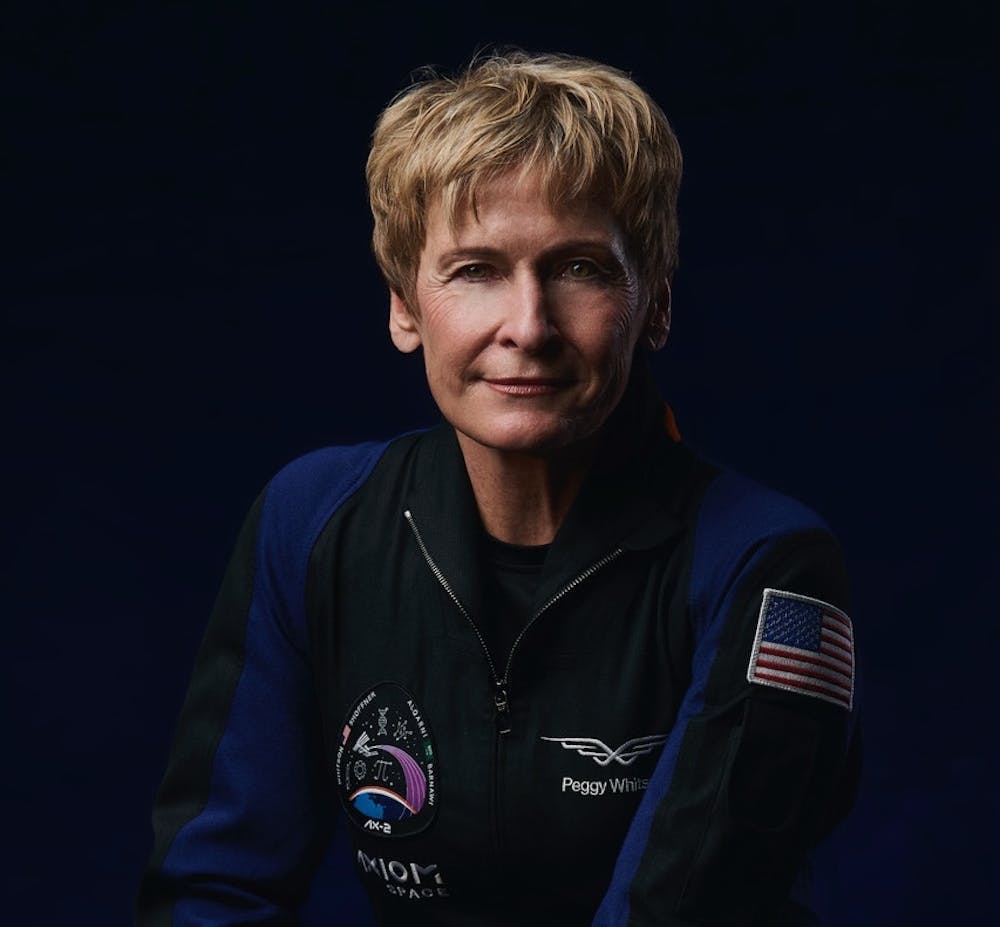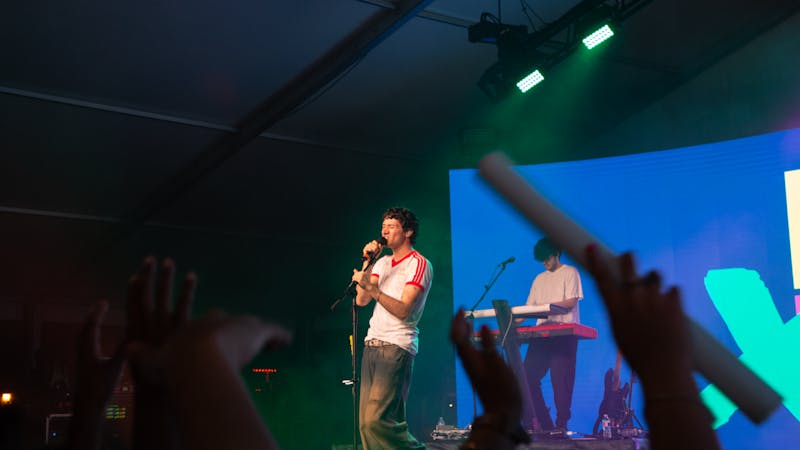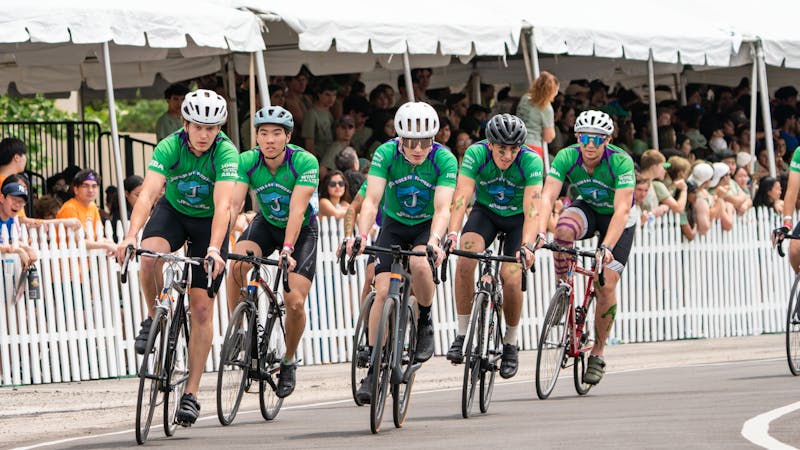Peggy Whitson breaks the glass ceiling, lands among the stars

Peggy Whitson has spent more time in space than any other American. She was the first female, nonmilitary Chief of the Astronaut Office for NASA and the first woman commander of the International Space Station, but despite all her success, Whitson denies any claims of special talent or giftedness. Above all else, she said, hard work and perseverance brought her to the top.
“I’ve always felt like it was important to be the best at my job,” Whitson, a Rice distinguished alumna, said. “I worked with a bunch of people who are wicked smart … but I would say work ethic was my secret weapon.”
Whitson grew up on a hog and soybean farm in a rural town near Beaconsfield, Iowa. She turned her gaze to the stars at age 9, when the Apollo 11 mission put men on the moon for the first time. Her dad flew planes for fun, and going on joy rides with him kept Whitson excited about the possibility of spaceflight, but the lack of an American female presence in space was discouraging at first. When Sally Ride and Shannon Lucid were announced as the first female and nonmilitary NASA astronauts in 1978, she realized a future in space exploration might be possible for her after all.
“It wasn’t until I graduated high school, and they picked the first female astronauts, that the dream became … a goal,” Whitson said. “That made it seem like a real possibility.”
Motivated from a young age, Whitson graduated as salutatorian from Mount Ayr Community High School in 1978, and earned a bachelor’s degree in biology and chemistry from Iowa Wesleyan College in 1981 before pursuing a Ph.D. and postdoctoral fellowship in biochemistry at Rice.
As she was nearing college graduation, Whitson was discouraged from pursuing a career in space by advisors who said her talents would be better put to use in medical school. One mentor even proffered a prediction that astronauts would have become obsolete by the time she reached her goals. But Whitson said her critics did little to deter her from the path she knew was right for herself. In fact, they only made her more persistent.
“It’s great to have the mentors, but it was also great to have a little bit of criticism along the way,” Whitson said. “It motivated me. I was going to prove that person wrong.”
Whitson’s Ph.D. advisor, Kathleen Matthews, was impressed with her from day one. She saw Whitson go above and beyond the discipline and drive required of most doctoral candidates, she said.
“[Some of] the experiments that needed to be done required a 48-hour time period … so she slept in my office for two nights with an alarm and got up and did what she needed to do, and then tried to go back to sleep,” Matthews, a Stewart memorial professor emeritus of biosciences at Rice, said. “She's a very calm person, she has an easy laugh and she has an incredible ability to focus.”
In 1986, Whitson began a postdoctoral research fellowship at NASA’s Johnson Space Center, but it took 10 years for her to be accepted into their astronaut program. In the meantime, she worked on several research and development projects, including a bone cell experiment executed on a 1992 joint mission between the U.S. and Japan and the ISS’s precursory Shuttle-Mir program; she served adjunct professor positions at the University of Texas and at Rice; and she held leadership roles such as deputy division chief of the medical sciences division at JSC and co-chair of the U.S.-Russian space science working group.
During her eight years of involvement in U.S.-Russian space activity, Whitson spent time in Moscow working in collaboration with what is now Russia’s Roscosmos State Corporation for Space Activities. Her work in Russia paved the path for her eventually becoming an astronaut, considering the long history of space relations between the two countries.
“The years in Russia were hard because she didn't go knowing the language, but she listened, saw how things were done in Russia, [and] I think that was very helpful to her,” Matthews said.
Whitson received a total of four rejection letters before finally being accepted to the program in 1996. By the time she had submitted her fifth and final application, she said she was an ideal candidate.
“Having all that leadership experience, showing that I worked [well] with international partners … made me more interesting to a selection board that was looking to hire astronauts to work on an international space station,” Whitson said. “[Those] 10 years were pivotal in me [becoming] the first female commander, the first female chief of the astronaut office, the first nonmilitary chief of the astronaut office.”
A six-month-long expedition to the ISS in 2002 was the first of Whitson’s three flights with NASA. She spent another six months on the ISS in 2008, and a nine-month-long stay at the station in 2016 marked her final trip with NASA.
Whitson and her crews were tasked with a number of responsibilities while onboard the ISS, such as infrastructure assembly, space walks and life and microgravity sciences research. Whitson took advantage of space’s unique environment to observe accelerated bone decay and cell proliferation.
“When you do experiments in space, you're using the lack of gravity to help you model or develop something,” Whitson said. “We did a lot of really cool research when I was with NASA."
Several hours of resistive and cardiovascular exercise was required of each crew member in order to combat the deteriorative effects that living in space has on the human body. Whitson said that each time she came back stronger than ever, but that returning to Earth was always a big adjustment.
“Even though I could bench press my body weight when I got back, I still felt like a klutz,” Whitson said. “We did 45 days worth of reconditioning to try and teach the little muscles how to work together [again]. Just jumping off of a step felt scary.”
Whitson was barred from state-supervised spaceflight after her third expedition due to radiation limitations, but she was determined to find another way to return to zero gravity, waving off health concerns.
“I’m not worried about it,” Whitson said. “I think [the limits] are too conservative, [and] it was particularly conservative for females.”
After retiring from NASA in 2018, she joined private space infrastructure firm Axiom Space and spent another 10 days in low-Earth orbit in May 2023. Currently, as Axiom’s director of human spaceflight, she helps engineer the space suits and stations of the future.
“I would probably say [I have] an addiction to space,” Whitson said. “I really love the experience; I love being a part of something that feels bigger than me.”
“When I left [NASA], I had no anticipation that commercial entities would be growing so quickly, but in less than five years, I was flying on a space mission [again],” Whitson continued. “The path isn't always a straight line right to your goals … You have to learn along the way.”
Editor-in-Chief Riya Misra contributed reporting.
More from The Rice Thresher

Rice Students for Justice in Palestine declares ‘liberated zone’ on campus
As student protests erupt across the country, Rice Students for Justice in Palestine launched a “liberated zone” on Rice campus, announced a two-day series of events and started construction on an “apartheid wall.”

Jeremy Zucker headlines second-ever Moody X-Fest
Jeremy Zucker headlined Rice’s second annual Moody X-Fest in Founder’s Court on April 19. In advance of Zucker’s set, student groups like Basmati Beats, Rice Philharmonic and BASYK performed. The festival also offered complimentary merchandise and food from Dripped Birra, Cane’s and Oh my Gogi.

Jones wins men’s and women’s Beer Bike races, GSA snags alumni
Jones College won both the women’s and men’s Beer Bike 2024 races, while the Graduate Student Association claimed the alumni team win. Hanszen College bike teams were the runner-up in the alumni and men’s races, while Brown College was the runner-up in the women’s race. Martel and McMurtry Colleges did not bike in the alumni race, according to the Rice Program Council’s final report, and the GSA was disqualified from the men’s race for accidentally sending out two bikers simultaneously.

Please note All comments are eligible for publication by The Rice Thresher.